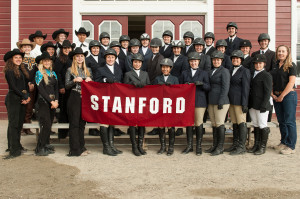On the far edge of West Campus, nestled behind the tennis courts, lies the Stanford Red Barn, a tranquil paradise of hay and sportsmanship where students, professional coaches and community members of all ages bond over a shared love of horses. The atmosphere in the stables is focused yet lively — people lovingly groom and dress the shining flanks of the horses while chatting amiably with one another — and outside, straight-backed Hunt Seat riders expertly guide their horses around obstacles as their coach shouts instructions and encouragement.

The Stanford Equestrian Team, which is comprised of 45 equine enthusiasts of a range of skill levels, is a club sport, but working with living, breathing animals differentiates it from the rest.
“As the Equestrian team is comprised not just of the 45 student athletes but Stanford’s 28 horses, it is important that we have athletes ready and willing to help with the care and management of the horses, many of whom are amazing athletes in their own right,” said Head Coach Vanessa Bartsch ’99.
Riders on the team recognize that they are dealing with a living creature, not just a piece of sporting equipment, and so an important part of every practice and show is prepping and caring for the horses.
“It’s a horse, not a football,” explained Co-President Alina Benavides ’14. “You have to maintain [its] health at all times.”
The team operates like a well-oiled machine, with students and professionals providing all levels of leadership and maintenance. They hire professional coaches, clinicians and veterinarians in order to provide important services to the riders and horses, but students provide much of the essential coordinating and management that keeps everything running smoothly.
Kolb and Benavides manage the team as a whole and deal with paperwork and outside organizations, while individual team captains work closely with their team members, horses and shows.
“As the western team captain I’m more responsible for my individual team members and the western team horses that we use, so it’s a closer level of communication,” Western Team Captain Julia Ishiyama ’13 said.
Ishiyama enjoys the camaraderie with her teammates and boasts of the fact that she has converted many of them into country music fans.
“We’re kind of a family,” she smiled. “I feel like momma bear.”

According to Kolb, students join the team with very different riding backgrounds. However, regardless of whether the team members have been riding for years or have very little experience, they all are considered essential to the overall success of the team.
“We try to take every rider seriously,” Kolb said. “It’s not like the higher level people are more important than the lower level riders.”
Kolb, who rides in the Hunt Seat division, has a long history of formal training, having taken her first formal lesson when she was eight years old. Benavides, on the other hand, grew up riding horses on her grandfather’s ranch, but had no formal training until she joined the equestrian team her freshman year.
“I didn’t train to show so that was a big challenge for me coming to Stanford and actually competing,” Benavides said. “I had the horse instinct, but I didn’t have the training to harness that instinct. After coming here and working with the coaches and my teammates, I really developed a greater understanding of horsemanship.”

Despite the differences in experience and riding style, what keeps the Stanford Equestrian Team going is its members’ shared admiration and respect for horses.
“I think what unites the team as a whole is each rider’s love of learning and, of course, love of horses,” Bartsch said. “Whether we are working with a new rider or with our top-riders, there is something magical about taking a break from classes, work and the 100 other activities each student seems to be juggling to spend a sunny afternoon at the Red Barn.”
